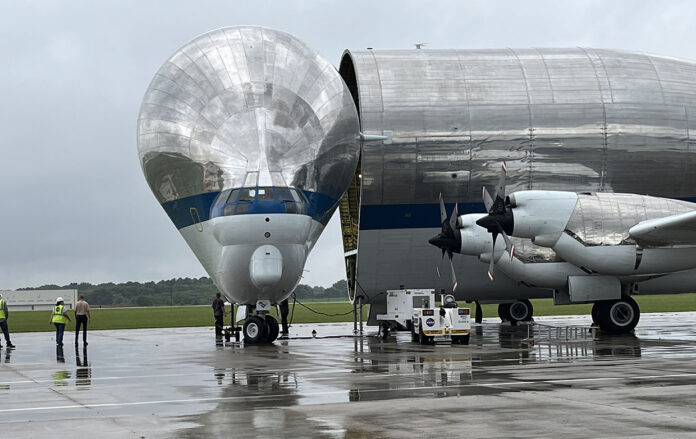HUNTSVILLE — Rain almost waterlogged NASA’s Super Guppy and prevented it from landing Wednesday at the Redstone Army Airfield.
But the fat fish-shaped transport plane touched down a little after 9 a.m., delivering the Orion stage adapter test article used in several test campaigns for the Space Launch System rocket at the Marshall Space Flight Center and the Kennedy Space Center in Florida.
The five-foot tall, 18-foot diameter test article is structurally identical to the one that will go into flight. The belt-like component to the Artemis “Moon to Mars” mission connects the rocket’s propulsion stage to the Orion spacecraft.
The test article will be permanently stored at the Marshall Center here in Huntsville. But the real craft will carry 10 CubeSats – or payloads – that will deploy and fly around by themselves conducting a variety of science and technology experiments.
These flying payloads are part of NASA’s CubeQuest Challenge, a competition that offers $5 million to teams that meet the objectives such as designing, building and delivering flight-qualified, small satellites capable of advanced operations near and beyond the moon.
“These CubeSats will fly 3 million kilometers from earth,” said Naveen Vetcha, CubeQuest Challenge Manager for NASA’s Centennial Challenge program. “Most of the CubeSats are in the lower compartment which is like 2,000 kilometers from earth, but we wanted to push that.
“Most small sats are very low cost but high risk. You can build them in a span of a couple of months and launch them easily, while big satellites are millions of dollars.
“We wanted to push small sat technology to go beyond into deep space.”
Unloading the gigantic test adapter ring took a couple of slow, soggy hours, delayed slightly by lightning strikes.
The cargo plane is a wonder in itself with its bulbous body and a cargo compartment that is 25 feet wide and 111 feet long. It is capable of hauling up to 48,000 pounds and its nose can open 110 degrees. This allows teams to load, unload and transport large hardware pieces and other space-related oversized cargo.
The Super Guppy was built in 1962 and has been used by NASA since then – rather old technology when compared to military transporters. However, its ability to move objects that are relatively light but very large, such as rocket components, from one side of the country to the other is still in high demand and the Guppy’s reliability is undeniable.
“The Super Guppy is a unique aircraft to maintain and operate,” said pilot Jack Roberts. “There is a sense of pride among the pilot corp, flight engineering team and technical engineering staff because there are very unique challenges and considerations about its age; however, the Super Guppy is still dedicated to its task, and I look forward to many more years of its service.”
Don’t miss out! Subscribe to our email newsletter to have all our smart stories delivered to your inbox.



